hood scoop
#21
I think adding the shaker is not the way to go. The XJS has a very large engine in a small space and air flow through the engine bay needs to flow front to back, exiting upwards NOT DOWNWARDS.
The louvers Ron has posted work well, I know a guy who had an XJS race car and these are a must to keep the V12 cool at full song with 600+hp
The louvers Ron has posted work well, I know a guy who had an XJS race car and these are a must to keep the V12 cool at full song with 600+hp
The following 2 users liked this post by warrjon:
Greg in France (04-15-2016),
ronbros (04-15-2016)
#23
The following users liked this post:
ronbros (04-16-2016)
#24
[QUOTE=warrjon;1442382]I think adding the shaker is not the way to go. The XJS has a very large engine in a small space and air flow through the engine bay needs to flow front to back, exiting upwards NOT backwards
A shaker scoop brings air into the ENGINE and has NOTHING to do with venting the engine compartment.
Louvers vent the engine compartment
A shaker scoop brings air into the ENGINE and has NOTHING to do with venting the engine compartment.
Louvers vent the engine compartment
#25
I did not say a shaker vents the engine bay. You quoted part of what I said and changed wording.
What I said and probably not very well is; A shaker goes is a high pressure area so it can suck air into a carburetor, adding a functional one to the XJS will cause air to be sucked into the engine bay in the middle of the bay this will reduce air flow through the radiator.
Yes louvers can vent the engine bay IF they are in the right spot, but most people put them at the back which is incorrect, they need to go in a low pressure area towards the front of the bonnet. Look at where Jaguar put the louvers on the XKR and Mitsubishi on the Lancer Evo
What I said and probably not very well is; A shaker goes is a high pressure area so it can suck air into a carburetor, adding a functional one to the XJS will cause air to be sucked into the engine bay in the middle of the bay this will reduce air flow through the radiator.
Yes louvers can vent the engine bay IF they are in the right spot, but most people put them at the back which is incorrect, they need to go in a low pressure area towards the front of the bonnet. Look at where Jaguar put the louvers on the XKR and Mitsubishi on the Lancer Evo
The following users liked this post:
ronbros (04-16-2016)
#26
I did not say a shaker vents the engine bay. You quoted part of what I said and changed wording.
What I said and probably not very well is; A shaker goes is a high pressure area so it can suck air into a carburetor, adding a functional one to the XJS will cause air to be sucked into the engine bay in the middle of the bay this will reduce air flow through the radiator.
Yes louvers can vent the engine bay IF they are in the right spot, but most people put them at the back which is incorrect, they need to go in a low pressure area towards the front of the bonnet. Look at where Jaguar put the louvers on the XKR and Mitsubishi on the Lancer Evo
What I said and probably not very well is; A shaker goes is a high pressure area so it can suck air into a carburetor, adding a functional one to the XJS will cause air to be sucked into the engine bay in the middle of the bay this will reduce air flow through the radiator.
Yes louvers can vent the engine bay IF they are in the right spot, but most people put them at the back which is incorrect, they need to go in a low pressure area towards the front of the bonnet. Look at where Jaguar put the louvers on the XKR and Mitsubishi on the Lancer Evo
I was once toying with the idea of putting vents on my AJ6 XJS like those on the E-Type (V12 example pic below, along with that of the $750,000 series I with hood open) but I can see that they are, indeed, located all the way to the back of the engine bay. Would this E-Type design vents actually reduce air flow through the radiator of my XJS?
Cheers,
#27
Then, the bonnet vents on the XKR's are closer to the middle of the engine bay (although the inside pics show the vents closer to the front of the hood) and I wonder if they are preferable for the XJS over the E-Type ones (which happen to be bigger, BTW). Pics below for the earlier 2001 XKR vents and the later 2012 XKR vents. View from outside and also inside the bonnet/hood.
Cheers,
Cheers,
#28
I think the vents on the E Type are too far back to be functional at speed, don't know for sure without driving the car with telltails taped to the bonnet. But WOW that car still look fabulous
The ones on the XKR are IMO in a better place.
My reasoning is.
At speed the air flows over the bonnet and hits the windscreen where it creates a high pressure zone, this is why the cabin air inlets are at the base of the windscreen. If you put these inlets in a low pressure zone on the bonnet you would get no fan assisted air in the cabin at speed. Open the drivers window and how much air comes in most stuff gets sucked out the window. This is like the front of the bonnet where air hits the front of the car and is forced over the bonnet.
So to get the air out of the engine bay the vents need to be in a low pressure zone on the bonnet. This will be just after the curve where the bonnet flattens out.
Best way to test is to tape telltails to the bonnet. If the telltails stream straight then this is a low pressure area. As pressure rises the telltails will buffet, curl or in a very high pressure area could droop and not move at all.
You could crack the bonnet open and tape telltails to trailing edge and go for a blast down the freeway, if these trail straight off the rear of the bonnet then air is exiting the back of the bonnet, my guess is they will either flutter around or curve under into the engine bay indicating air is being sucked into the bay from the rear
The ones on the XKR are IMO in a better place.
My reasoning is.
At speed the air flows over the bonnet and hits the windscreen where it creates a high pressure zone, this is why the cabin air inlets are at the base of the windscreen. If you put these inlets in a low pressure zone on the bonnet you would get no fan assisted air in the cabin at speed. Open the drivers window and how much air comes in most stuff gets sucked out the window. This is like the front of the bonnet where air hits the front of the car and is forced over the bonnet.
So to get the air out of the engine bay the vents need to be in a low pressure zone on the bonnet. This will be just after the curve where the bonnet flattens out.
Best way to test is to tape telltails to the bonnet. If the telltails stream straight then this is a low pressure area. As pressure rises the telltails will buffet, curl or in a very high pressure area could droop and not move at all.
You could crack the bonnet open and tape telltails to trailing edge and go for a blast down the freeway, if these trail straight off the rear of the bonnet then air is exiting the back of the bonnet, my guess is they will either flutter around or curve under into the engine bay indicating air is being sucked into the bay from the rear
Last edited by warrjon; 04-18-2016 at 06:28 AM.
#29
Just found these. They show what I mean when I said in another post I don't think lifting the back of the bonnet will cause air to flow out, more likely it will flow in.
The tuffs between the rear of the bonnet and the windscreen are flowing towards the front of the car.
The tuffs between the rear of the bonnet and the windscreen are flowing towards the front of the car.
Last edited by warrjon; 04-18-2016 at 06:42 AM.
The following users liked this post:
ronbros (04-20-2016)
#30
Warren, Guys
Sun came out this afternoon, so I borrowed some wool from Madame's Ma and set about the job.
I taped, as shown in the attached photos: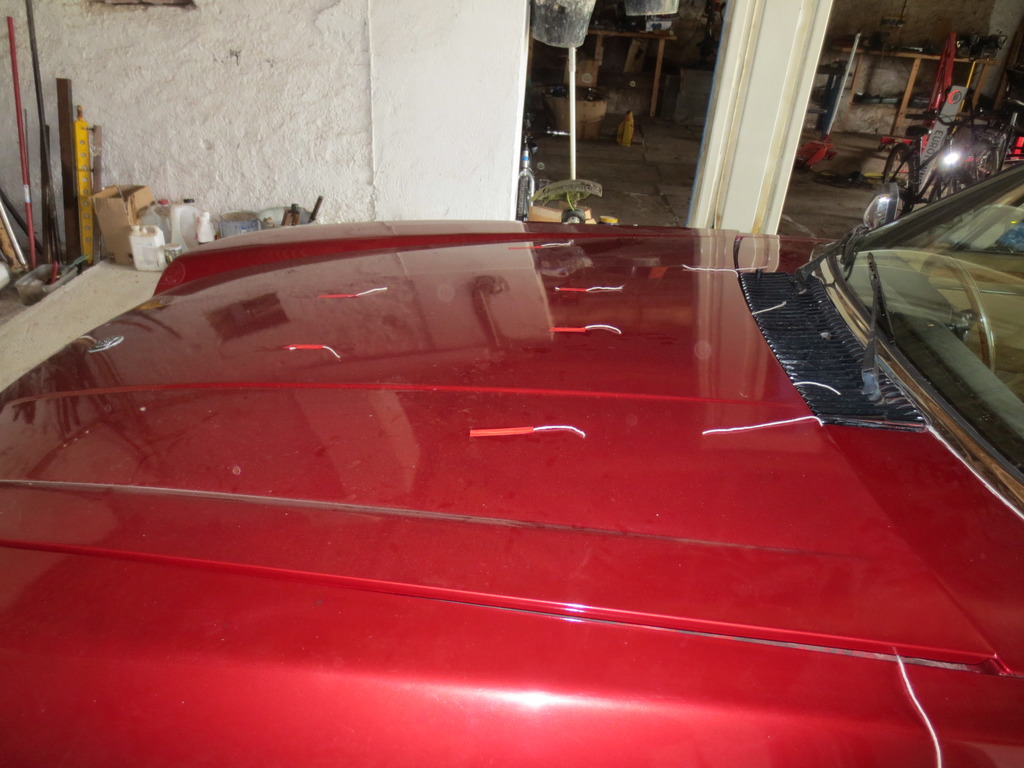
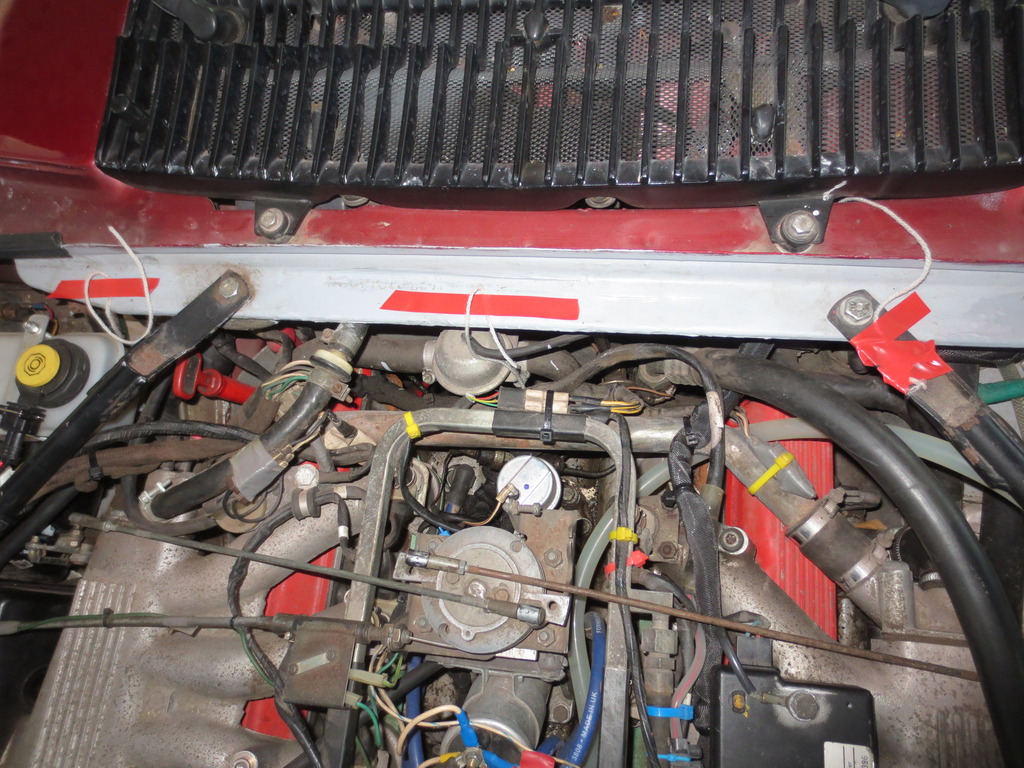
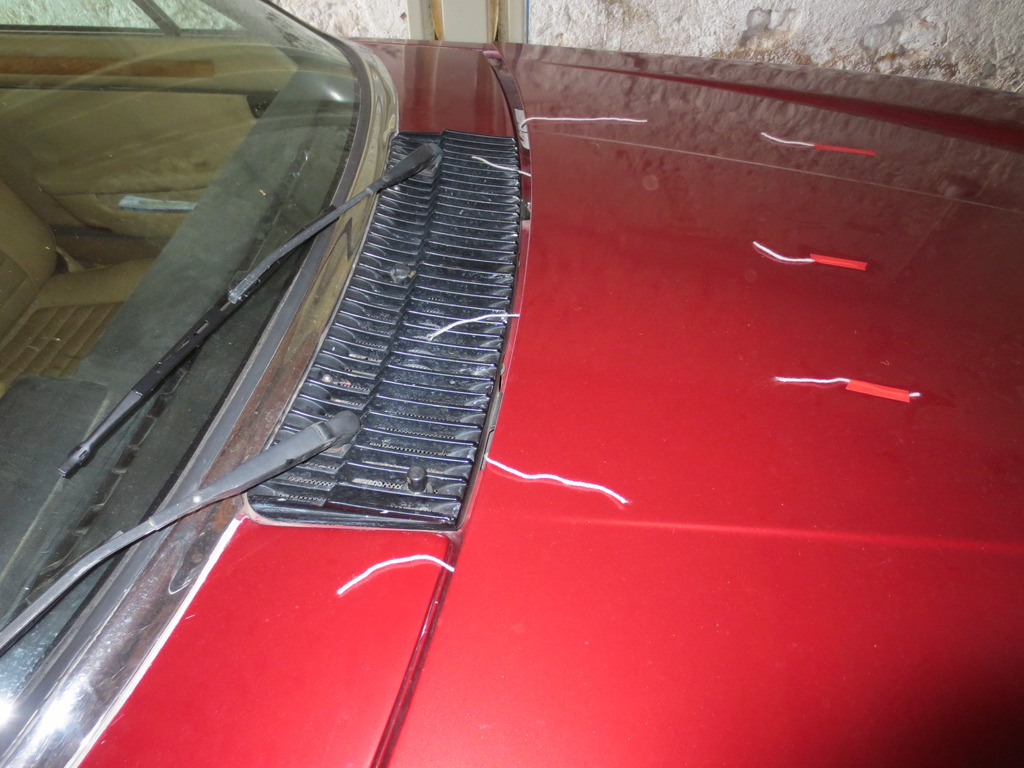
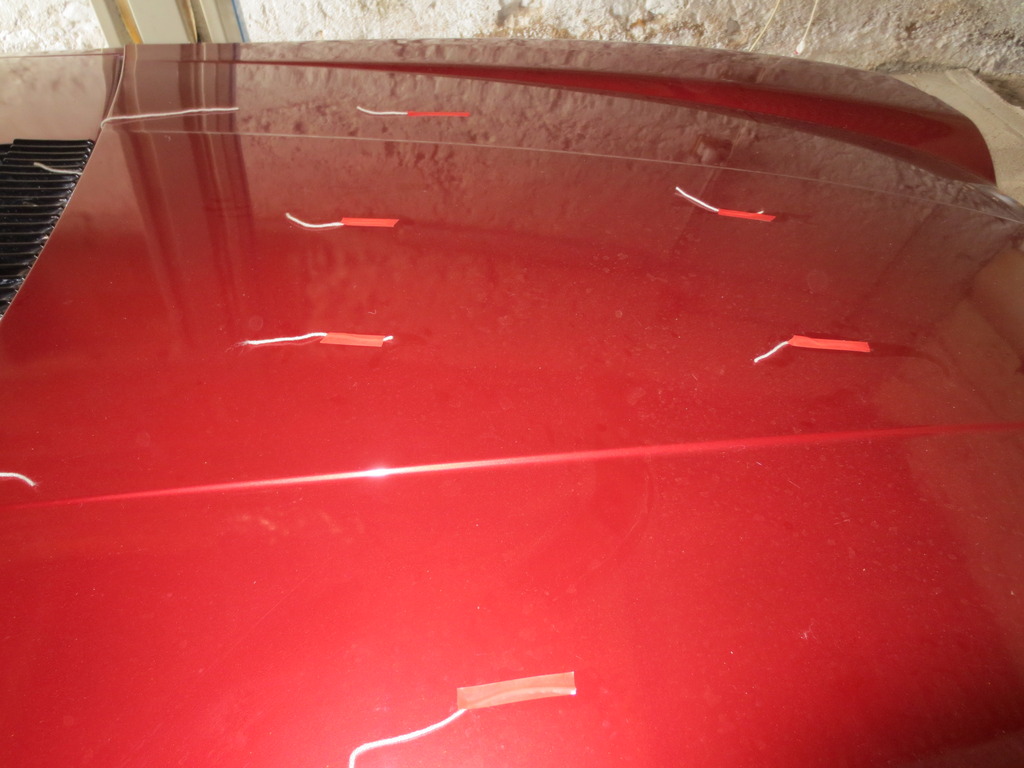
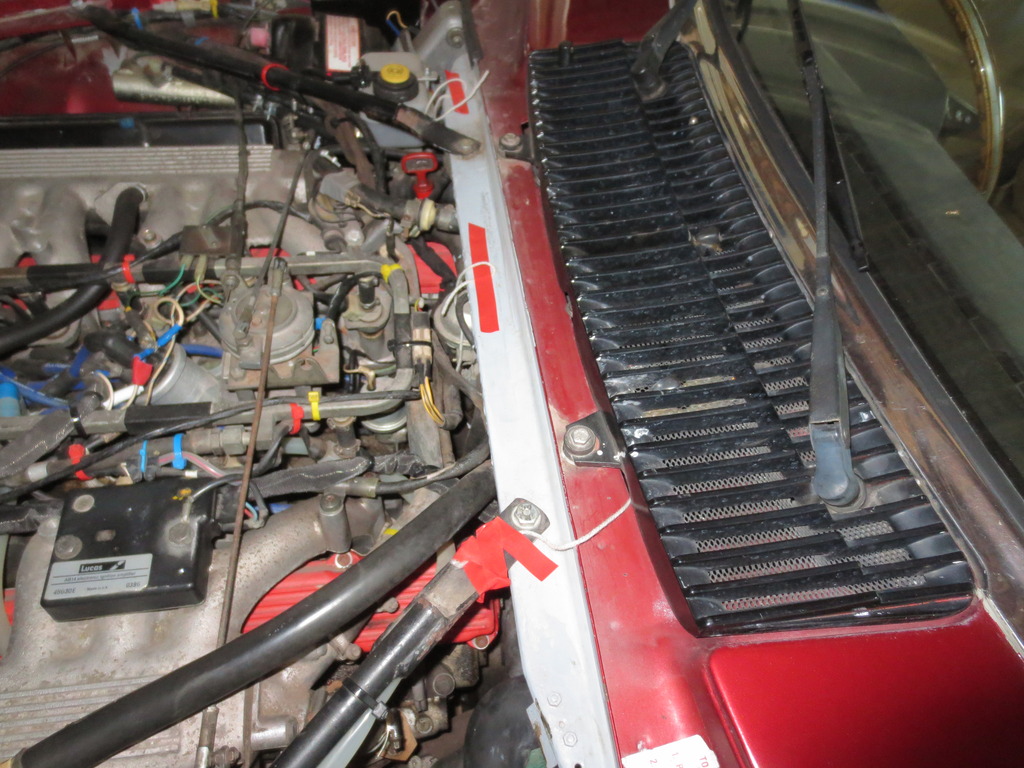
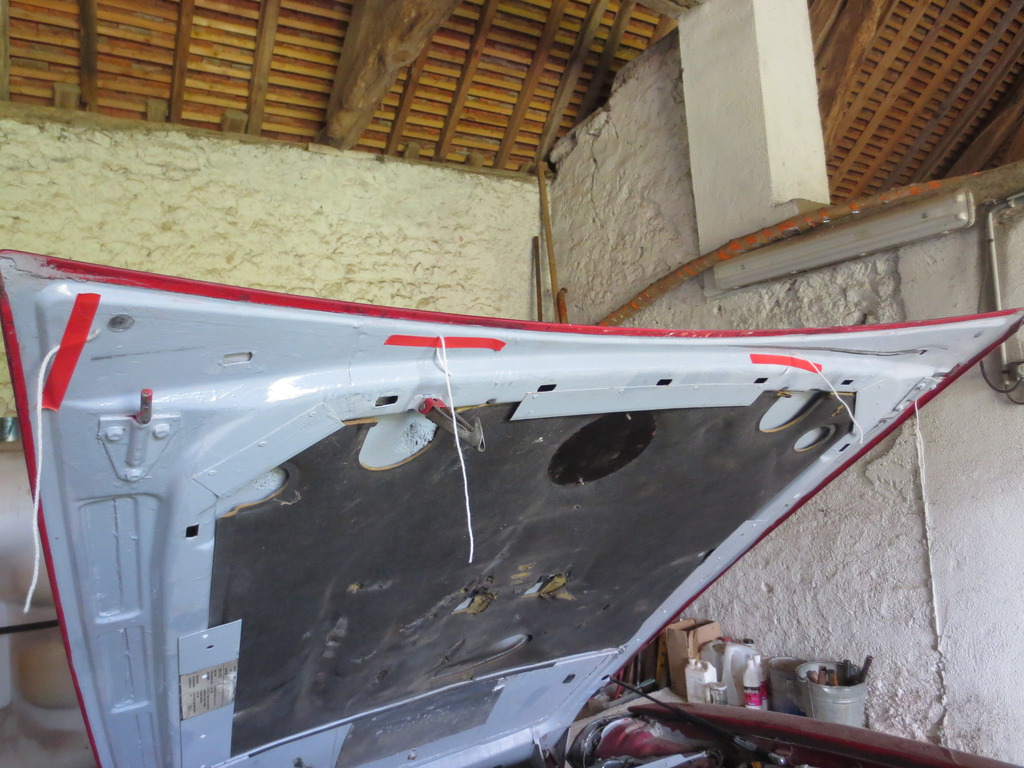
Off for test 1. First bonnet unfastened held on the safety catch. The bonnet rises to the full extent it can at about 50 KPH (30 MPH) so there is high pressure under there somewhere!
Results test 1:
Those attached on the rear of the engine bay: ALL were sucked back into the bay at all speeds up to 90 KPH (55 MPH).
Those on the rear of the bonnet pressing attached INSIDE: two sucked back inside, the outermost A bank side one sucked sideways towards the wing
Those on the side of the bonnet pressing attached 10 and 15 cm forward from the corner: Strongly sucked outwards
Those on the outside of the bonnet dead flat and pointing straight backwards at all speeds.
Test 2 First bonnet fastened
Those attached on the rear of the engine bay: ALL were sucked back into the bay at all speeds up to 90 KPH (55 MPH).
Those on the rear of the bonnet pressing attached INSIDE: ALL sucked back inside, (remember I have removed the most part of the rear bonnet seal).
Those on the side of the bonnet pressing attached 10 and 15 cm forward from the corner: Strongly sucked outwards.
Those on the outside of the bonnet dead flat and pointing straight backwards at all speeds.
From all this I conclude:
Greg
Sun came out this afternoon, so I borrowed some wool from Madame's Ma and set about the job.
I taped, as shown in the attached photos:
- Three strands to the back of the engine bay long enough to stick out to the outside by a couple of inches,
- Three to the rear of the bonnet pressing INSIDE, ditto
- One each side to the bonnet pressing attached INSIDE near the catch hook each side, one 15 cm forwards from the rear corner; one 10 cm forwards from the other corner
- several all over the bonnet top on the outside.






Off for test 1. First bonnet unfastened held on the safety catch. The bonnet rises to the full extent it can at about 50 KPH (30 MPH) so there is high pressure under there somewhere!
Results test 1:
Those attached on the rear of the engine bay: ALL were sucked back into the bay at all speeds up to 90 KPH (55 MPH).
Those on the rear of the bonnet pressing attached INSIDE: two sucked back inside, the outermost A bank side one sucked sideways towards the wing
Those on the side of the bonnet pressing attached 10 and 15 cm forward from the corner: Strongly sucked outwards
Those on the outside of the bonnet dead flat and pointing straight backwards at all speeds.
Test 2 First bonnet fastened
Those attached on the rear of the engine bay: ALL were sucked back into the bay at all speeds up to 90 KPH (55 MPH).
Those on the rear of the bonnet pressing attached INSIDE: ALL sucked back inside, (remember I have removed the most part of the rear bonnet seal).
Those on the side of the bonnet pressing attached 10 and 15 cm forward from the corner: Strongly sucked outwards.
Those on the outside of the bonnet dead flat and pointing straight backwards at all speeds.
From all this I conclude:
- removing the rear bonnet seal is a waste of time except when the car is stationary, when it does allow easier hot air exit from the engine bay. I shall be replacing this seal!
- as Warrjon said, there IS DEFINITELY a high pressure area at the rear of the bonnet that DOES feed air back into the engine bay when the car is moving unless that rear join is sealed
- HOWEVER there IS, once you are 10 to 15 CM forward of the rear bonnet/firewall join, a definite easy natural path for engine bay hot air to escape when the car is moving through any vent that might be there. This conclusion is based on the fact that the wool each side attached to the bonnet inside by the catch hooks ALWAYS, bonnet open or shut, strongly stood out into the airstream and was never sucked back into the engine bay.
Greg
#31
Which indicates that the XKR vents would be correct where located, but it leaves a question mark for the full rear location that Jag engineers gave to the E-Type vents where, apparently, air goes in instead of out. Is it possible that, for some reason that was, indeed, their intention? And, if so, would that be to help/force the final segment of under-hood air path flow down to the road?
BTW, one of the pics that I posted in one of the previous entries here included a number in its title, as in "$750,000". Did that call anybody's attention, or perhaps you all know about this already?
Cheers,
BTW, one of the pics that I posted in one of the previous entries here included a number in its title, as in "$750,000". Did that call anybody's attention, or perhaps you all know about this already?
Cheers,
#32
Which indicates that the XKR vents would be correct where located, but it leaves a question mark for the full rear location that Jag engineers gave to the E-Type vents where, apparently, air goes in instead of out. Is it possible that, for some reason that was, indeed, their intention? And, if so, would that be to help/force the final segment of under-hood air path flow down to the road?
Cheers,
Cheers,
#33
The following users liked this post:
Greg in France (04-19-2016)
#34
Assuming it is, and do please give us your view, then I am assuming that anywhere the wool is flat will be suitable for louvres. The main thing I am concerned about is where the water goes when it rains. I am not concerned about the metalwork, but about the electrics, and I do not want to use interior baffles.
I actually have in stock a spare bonnet with a dent in the front, so I just might vandalise it with a few home made holes and do a test to see what happens when I put the holes in the place I am thinking of placing the louvres.
Greg
Last edited by Greg in France; 04-19-2016 at 05:28 AM.
#35
Greg
#36
IIRC the carbs on the 6 cyl etype pick up air from the front through a square tunnel in the bonnet structure and on the 12cyl the vents are above the carbs but again the carbs pick up air from the front. On the 12cyl there are rain deflectors right above the carbs and below the louvers. From everything I've seen the louvers on the etype are to exit air from the bonnet not to bring air in for the carbs.
The following users liked this post:
Dr Quail (08-05-2016)
#38
#39
The simple answer is YES where the wool lies flat is a low pressure area. If you put the vent there the low pressure will in effect suck air out from under the bonnet, like a reverse ram effect.
The following 2 users liked this post by warrjon:
Greg in France (04-20-2016),
ronbros (04-24-2016)
#40
Join Date: Jul 2010
Location: Austin tx and Daytona FL.
Posts: 7,362
Received 1,231 Likes
on
939 Posts
hey guys ,thanks for all the info, seeing as most overheats are after you slow in heavy traffic, or stop and shut engine down! that loosen valve seats in V12s.
is why GM and Cowl Induction hood system would open and close to better control air flow,(it had a small vacuum door in the cowl scoop) most think it was for cool air when at full throttle, which it was) but was closed when slow and stopped!
course they had an air box to feed the carb. connected direct to the scoop, and introduced hot underhood air,( MPG & eminssion crap,for slow speeds.
be nice to read there papers on the engineering involved!
but on my car ,i kinda like the idea of air flow,with electric fans 2, when stopped or going slow, like i said i cant see any increased heat at hiway speeds, going by my 2* increment digital readout gage. it reads the highest after slowing or shut down.
i'm like many here, somewhat paranoid about overheats!
NASCAR guys started using wind shield pressure in early late 50-60s.
seems that Daytona guy Smokey Yunick, 1st became of it aware of it from early 30s Fords with the manual cowl vent for air into the cabin(darn think of it at 20-30MPH it worked well for cooling interior, But i myself remember closing vent because it was to much air ,sometimes cold when up around 50-60MPH.)
my 1st car 1934 Ford roadster, with hand vent right at base of shield (almost straight up).
oops, more useless info. more stuff to think about, theory is one thing reality is another!
is why GM and Cowl Induction hood system would open and close to better control air flow,(it had a small vacuum door in the cowl scoop) most think it was for cool air when at full throttle, which it was) but was closed when slow and stopped!
course they had an air box to feed the carb. connected direct to the scoop, and introduced hot underhood air,( MPG & eminssion crap,for slow speeds.
be nice to read there papers on the engineering involved!
but on my car ,i kinda like the idea of air flow,with electric fans 2, when stopped or going slow, like i said i cant see any increased heat at hiway speeds, going by my 2* increment digital readout gage. it reads the highest after slowing or shut down.
i'm like many here, somewhat paranoid about overheats!
NASCAR guys started using wind shield pressure in early late 50-60s.
seems that Daytona guy Smokey Yunick, 1st became of it aware of it from early 30s Fords with the manual cowl vent for air into the cabin(darn think of it at 20-30MPH it worked well for cooling interior, But i myself remember closing vent because it was to much air ,sometimes cold when up around 50-60MPH.)
my 1st car 1934 Ford roadster, with hand vent right at base of shield (almost straight up).
oops, more useless info. more stuff to think about, theory is one thing reality is another!
Last edited by ronbros; 04-20-2016 at 03:14 PM.


